The Apple iPad Air 2 Review
by Joshua Ho on November 7, 2014 9:30 AM EST- Posted in
- Tablets
- Apple
- Mobile
- iOS
- ipad Air 2
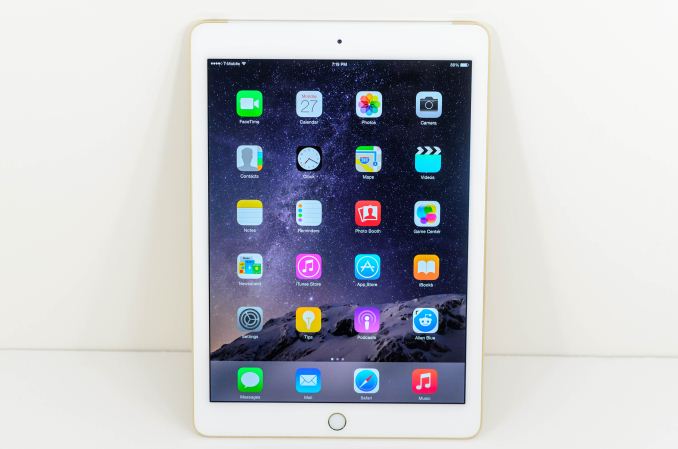
As we approach the holidays, Apple has launched a new iPad as expected. As one might expect from the name, the iPad Air 2 is more of an evolution of the original iPad Air than a clean-sheet design. This doesn’t mean that there’s little to talk about though, as Apple has gone a long way to improve every aspect of the iPad Air with this iteration. However, with this generation Apple seems to be under fire as Google attempts to push into the premium tablet space with the Nexus 9.
Without question though, the iPad line defines what an ARM-based tablet is. The iPad Air 2 is undoubtedly a part of this lineage with its focus on a large touch-screen display. This level of design minimalism is responsible for at least part of the original reaction to the tablet as a “large phone”. However, by virtue of its sheer size there are new possibilities opened up in terms of content consumption and even content creation. In the basic definition of a tablet, the iPad Air 2 definitely fits. There’s a new SoC, more RAM, a better display lens, new cameras, and an even thinner design, but all of these things don’t change the fact that this is a 9.7” display that can only be interacted with through a touchscreen. In the interest of saving space and time, I’ve included a spec sheet below to cover all bases.
| Apple iPad Air 2 | |
| SoC | 3x 1.5 GHz CPU A8X |
| RAM/NAND | 2GB LPDDR3 + 16/64/128GB NAND |
| Display | 9.7" 2048x1536 IPS LCD |
| Network | WiFi only or 2G / 3G / 4G LTE SKU |
| Dimensions | 240 x 169.5 x 6.1 mm, 437g WiFi, 444g LTE |
| Camera | 8MP Rear Facing with F/2.4 aperture, 1.3MP FFC |
| Battery | 7340 mAh (27.62 Whr) |
| OS | iOS 8.x |
| Connectivity | 802.11a/b/g/n/ac + BT 4.1, USB2.0, GPS/GNSS |
As with any other mobile device, one of the most immediate impressions one can form is that of design. This may be one of the most important areas as well, because every mobile device is constantly held or otherwise handled. These devices tend to be deeply personal as well, which means that there’s a great deal more emphasis on industrial design than a desktop tower that gets shoved into a dark corner for five years at a time.
To this end, the iPad Air 2 does quite well. The design is definitely separate from the iPhone 6 line, as the metal chamfer remains, but the form continues to be quite pleasing. On the front face of the tablet, we see a single 1.2MP camera, the display, and the home button which has TouchID built in. The glass is flat, which makes it seem noticeably different from the iPhone 6 line in that regard as it meets the chamfered edge of the back cover rather than making a seamless curve. The radius of the curve is also noticeably different as a result, simply curving in towards the center of the device rather than curving out of the device. If anything, this does make the iPad Air 2 feel a bit thicker in the fingers but the device overall is still incredibly thin.
Speaking of the back cover, there’s really almost nothing to speak of on the back cover. There’s the 8MP camera and a microphone hole, but not much else other than the large plastic RF window on the top edge of the tablet. The curve of the sides does make it seem like there’s a great deal more on the back cover though. Other than the RF window, there’s a power button and 3.5mm jack on the top of the tablet. Next to the power button are the volume buttons, but curiously no mute/lock rotation switch for this generation. I suspect that the reasons for this deletion are primarily due to user confusion, although my experiences are purely anecdotal in this regard. Finally, along the bottom of the device we see the Lightning port and two speaker grilles.
Overall, the design of the iPad Air 2 is impressive. The thin feel is really quite impressive when compared against other devices, but the weight no longer feels quite as incredible as the original iPad Air when compared to the iPad 4.
Outside of the physical design, Apple has also included a selection of two cases which include the smart cover and case, which are mostly unchanged from the previous generation except to fit the iPad Air 2. I don’t have much to complain about here although the smart case has a bit more flex on the sides than I’d like. The smart cover does have enough strength in the magnets to hold the tablet by the cover, although I wouldn't recommend doing this.


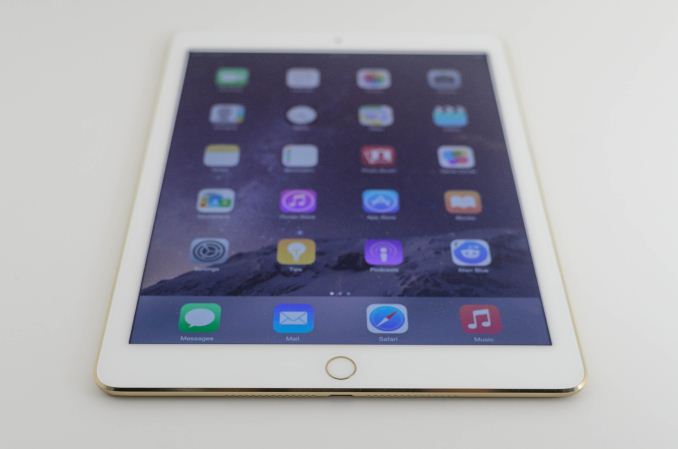
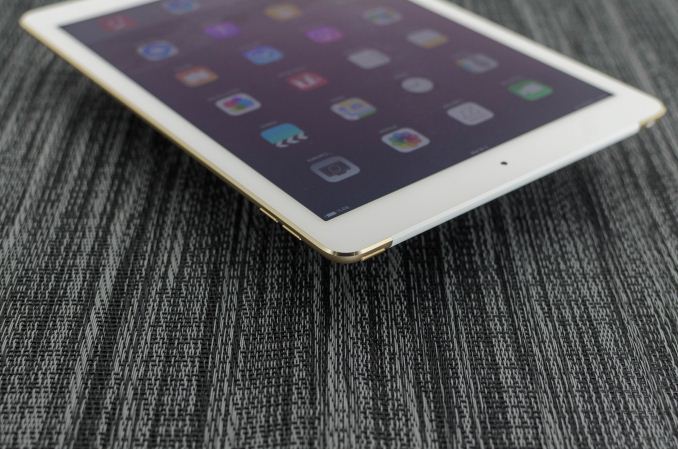
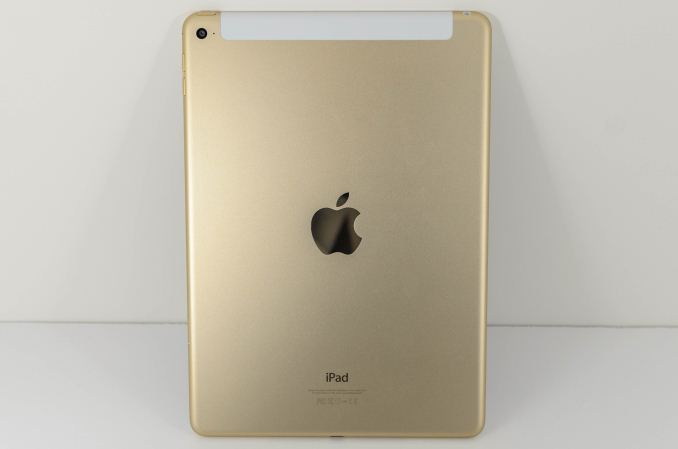

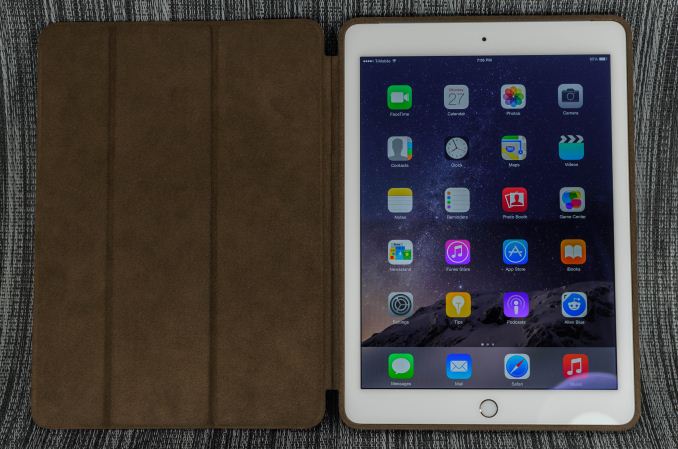








226 Comments
View All Comments
DosOldie - Sunday, November 9, 2014 - link
I still have an iPad 2 and I do not plan on upgrading my iPad until there is add on space. Put in a usable SD slot and I' ll upgrade. Adding & deleting apps will not change w a new iPad w the same amt of space.ws3 - Wednesday, November 12, 2014 - link
So you will never be upgrading...tralalalalalala40 - Thursday, November 13, 2014 - link
See the iStick... You see. everything is going wireless. They have wireless HDs from toshiba that are for the iPad now. You don't need a random dust collecting/battery dwindling port to get done what you want to get done.sdagley - Monday, November 10, 2014 - link
The line "I’m not necessarily sold on TouchID on a tablet as an ergonomic ideal as the sheer width of the device makes it a bit harder than usual to properly place my finger for scanning" in the Final Words section doesn't make sense. The TouchID sensor works with multiple fingers at any any orientation which makes it easy to use no matter how you're holding it. This review makes it sound like Apple uses the old style vertical swipe sensor like the Galaxy S5 usesLgFriess - Monday, November 10, 2014 - link
Just picked up an Air 2 over the weekend. I'm no Apple fan boy (PC gamer, Note 3 phone and don't think I'll ever go back to an iphone, and I generally despise itunes) , I just wanted what I thought would work best for me. After agonizing for months over every tablet out there including the Nexus 9, I just liked the Air 2.The cons (since that's what everybody seems interested in);
1. It's almost too thin. It feels delicate to me. I'd much rather have a bit thicker tablet with a more substantial feel. Stop with the thin thin thinner crap. Of course I have a case on the way but still.
2. The vibration. Yep it's definitely there. However, I can't think of any situation that this would bother me in the least bit. I wouldn't have thought to mention it but I saw so many comments here saying it's worse then ebola. There is no way somebodies fingers are going numb when holding it. People are starting to make up things to enforce their argument. The vibration certainly goes back to problem 1. Too thin, too light, too delicate in the hand.
3. Speakers. Not that I'm expecting anything great on a tablet but I sure like the thought of the Nexus front facing speakers. It's just a better solution. The ipad speakers aren't bad at all. They're just typical tablet speakers.
All in all, it's been a great addition. Fast, smooth, great apps (just tried Hearthstone for the first time, and as a PC gamer, I'd say it makes a great tablet game which I generally can't stand), display is gorgeous, battery life is longer then expected though gaming will eat it up quickly. The fingerprint ID thing IS nice, which surprises me as I wouldn't have thought I would care.
Very happy with my purchase.
LgFriess - Monday, November 10, 2014 - link
One other thing. There is absolutely NO distortion just holding the tablet. Another instance of over dramatization. I've put a little pressure into the back and didn't notice any distortion in that case either, but as I've said above, I do feel it's too thin/delicate and I'm afraid I'll damage it if I were to squeeze it too much. By "too much" I mean actively trying to bend it to see if the screen will distort, but not under normal use.tralalalalalala40 - Thursday, November 13, 2014 - link
When I pile-drive my LCD monitors at work they distort so I took them back.yhselp - Monday, November 10, 2014 - link
It's worth mentioning that this is the first handheld device (apart from full-fledged Windows tablets) truly close to last-gen gaming consoles in terms of performance - 25.6 GB/s memory bandwidth and a powerful triple-core CPU. It'd be interesting to see how the 1.5 GHz enhanced Cyclone stacks against the 3.2 GHz PowerPC in the Xbox 360.spammy39 - Tuesday, November 11, 2014 - link
Is there any reason why Anandtech does not include the Surface Pro 3 on the benchmark list?Fairshare - Wednesday, November 12, 2014 - link
Do you see any Intel Core based tablets here? The Surface Pro 3 is a PC that just happens to be a tablet so it's not really comparable in terms of performance. You might compare other statistics such as battery, display etc. but it's otherwise a completely different animal.